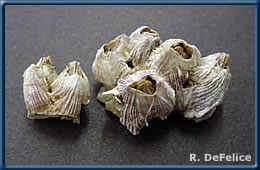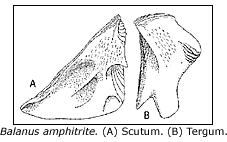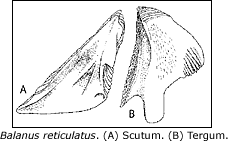

Balanus ampitrite

Balanus eburneus

Chthamalus proteus

Gonodactylaceus falcatus

Ligia exotica

Pachygrapsus fakaravensis

Scylla serrata
Balanus amphitrite
 Striped
barnacle
Striped
barnacle
Phylum Arthropoda
Subphylum Crustacea
Class Maxillopoda
Subclass Cirripedia
Order Thoracica
Family Balanidae
Description
Balanus amphitrite is a small, conical, sessile
barnacle (to about 1.5 cm diameter). Color is whitish with purple or brown
longitudinal stripes. Surface of test plates are longitudinally ribbed.
The interlocking tergum and scutum, the paired structures which cover
the animal inside are as pictured below.
 A
similar species, Balanus reticulatus Utinomi,
is also an introduced species and commonly occurs with B.
amphitrite. It also has longitudinal purple or brown stripes, but
these stripes are intersected by horizontal grooves, giving the surface
of the test plates a rough reticulated striation, unlike B.
amphitrite. It can also be distinguished by examination of the
tergum and scutum pictured below. Note the more sharply pointed apex of
the tergum and the elongated and narrower tergum spur of B.
reticulatus.
A
similar species, Balanus reticulatus Utinomi,
is also an introduced species and commonly occurs with B.
amphitrite. It also has longitudinal purple or brown stripes, but
these stripes are intersected by horizontal grooves, giving the surface
of the test plates a rough reticulated striation, unlike B.
amphitrite. It can also be distinguished by examination of the
tergum and scutum pictured below. Note the more sharply pointed apex of
the tergum and the elongated and narrower tergum spur of B.
reticulatus.
Habitat
Very common in the intertidal fouling communities of harbors and protected
embayments. The live attached to any available hard surface, including
rocks, pier pilings, ship hull, oyster shells, and mangrove roots.
 Distribution
Distribution
Hawaiian Islands
Throughout the main Hawaiian Islands
Native Range
Southwestern Pacific and Indian Ocean
Present Distribution
World-wide in warm and temperate seas
Mechanism of Introduction
Unintentional, as fouling on ships hulls
Impact
Barnacles are a serious fouling problem on ship bottoms, buoys,
and pilings. The ecological impact of this barnacle in Hawaii is unstudied.
Ecology
Feeding
Barnacles have specialized paired appendages, called cirri, that they
use as a scoop net, reaching out into the water and extracting food particles.
When they cirri are drawn back, food is scraped off into the mouth.
Reproduction
These barnacles are hermaphrodites, but cross-fertilization occurs in
dense populations. In such cases, males deposit sperm directly into the
mantle cavity of adjacent functional females via a long tube. Fertilized
eggs are brooded in the mantle cavity, and it may be several months before
the free-swimming planktonic larvae are released.
Remarks
This now widespread barnacle of southern hemisphere origins was first
collected in 1902 in Honolulu Harbor. Edmondson (1933, as Balanus
amphitrite hawaiiensis) noted that it was very common in Pearl
Harbor on piling and shore rocks. Both B. amphitrite
and B. reticulatus are well established in
Hawaii and have been widely reported by many authors throughout the main
Islands.
References
Edmondson, C.H. 1933. Reef and Shore Fauna of Hawaii. B.P. Bishop Mus.
Spec. Pub. 22.
© 2002 Hawaii Biological Survey, Bishop Museum
contact